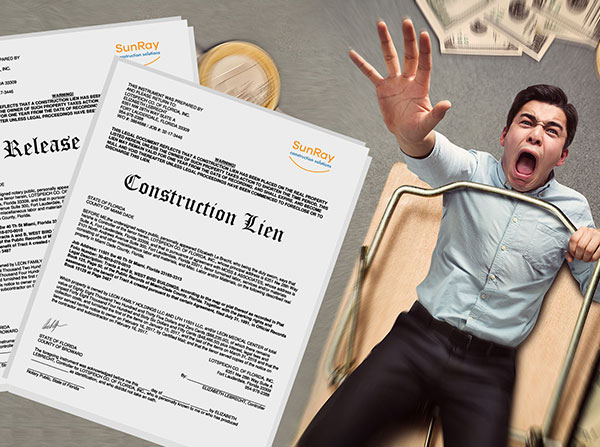I've Received a Claim on my Payment or Performance Bond! Now What? - Webinar
So you received a claim on your payment bond or performance bond. Learn what you should do after, what kind of notice you will receive, and when you should retain a construction lawyer.
Last updated:
Nov
07
,
2025
Published:
Dec 15, 2020
10 Mins
Read
Payment bonds and performance bonds are important documents and you should know what to do after receiving a claim on them. Bonding gives you a competitive advantage over non-bonded contractors. Learn what the first notice is that you will receive when a claim is made, what a Notice of Nonpayment does, what you should do once a claim is made, and why you should retain a construction lawyer.
This blog was taken from a webinar that was presented by SunRay Construction Solutions and Alex Barthet, a board-certified construction lawyer in lawyer. It also features the guest Warren Alter, Founder and President of Alter Surety Group who has 25 years of experience under his belt. In this blog, we discuss what you should do after you receive a claim on your payment or performance bond.
What Is a Payment and Performance Bond?
Although most people hope that their projects will be perfect, sometimes things go wrong. That is one of the reasons owners bond their projects to have somewhere to turn when the contractor gets in trouble. The other reason is to have an independent third-party surety verify that the contractor is in fact qualified to perform the job.
This is called a pre-qualification of the contractor. In the underwriting process, the surety evaluates the capital capacity character of the prospective contractor to assure the project owner that the contractor is able to complete the project before the surety commits to provide the bonds.
The bond is basically comprised of a three-party agreement. You have the principal which is typically the contractor, or it could be a subcontractor. Then you have the obligee who gets the benefit of the bond or the beneficiary. Lastly, you have the surety, which is the insurance company.
Bonds are a non-traditional insurance product, and they are underwritten for zero losses which is unlike normal insurance. With normal insurance, you have actuaries and statisticians that basically calculate for every dollar they take in a premium, how much they expect to pay out on losses.
With bonds, the sureties charge a very nominal fee ranging from half a percent to three percent depending on numerous factors, the surety involved, the financial strength, the relationship, etc. So, if there is a loss, a surety looks to be made whole or indemnified. So, bonding is a little bit different from your normal insurance. It is more similar to a credit product such as a bank loan.
What is a payment bond?
A payment bond is mandated by law as it relates to public and federal projects. What this type of bond does is, it protects subcontractors and suppliers who do not have the ability to lien public property. As you probably already know, public property cannot be liened. So, the only stopgap for subcontractors and suppliers on a project is the prime contractor’s payment bond as relates to private jobs, it is not mandated by law. That is up to the discretion of the owner or lender.

What is a performance bond?
A performance bond guarantees all the contract terms, conditions, specifications, the agreed upon contract sum, the specific duration of the project but encompasses any delay damages, and the warranty provision. So, the bond is typically on the hook for everything that is within that contract, and the bond guarantees it.
Both the performance and payment bonds typically go hand-in-hand, so they are always issued together.
About the General Indemnity Agreement
The General Indemnity Agreement or General Agreement of Indemnity is an agreement that is always required in the surety relationship between the principal and the surety. It is a very one-side agreement, but it lays out the rules and conditions in the event that the surety incurs a loss or anticipates incurring a loss.
In that agreement - as mentioned above about bonds being an indemnity product – if the surety does have a loss, they look to be made whole. It being a credit product and the surety being an unsecured party, they are required to get the personal guarantees of the stockholders of the company, as well as the spouses of the stockholders.
The bond does not protect the contractor
The bond is not there for the protection of the principal or the person who is obtaining the bond for the obligee. The bond is for the benefit of the obligee. But the contractor is the one who has to go and obtain the bond. They have to qualify with the surety and go through the strenuous underwriting process. The relationship exists between the surety and the principal. The obligee is the third-party beneficiary to having the bond.
Bonding is a competitive advantage over non-bonded contractors
Anyone who has a knowledge of bonds, as it relates to being an owner or lender, knows that a contractor who is bonded has gone through a strenuous underwriting process. The surety has basically pre-screened and has done their underwriting due diligence. They have evaluated the contractor’s background, the jobs they have completed in the past, the sizes of the jobs, the financial strength of the company, and the cash flow of the company.
A bonding company that is willing to provide a bond is endorsing that contractor and backing it with their own financial resources in the event that the contractor should default. The bonding contractor has been through a strenuous process, unlike one that may not have obtained bonds.

What Is the First Notice I Will Likely Receive When a Claim Is Made?
When a claim is made on a bond, what is the first thing that you as the bonded contractor will do? Let us take an example. You are a contractor, you have gone through the effort of getting bonded, you have a payment and performance bond, and now on one of your projects where you have a payment bond, you get a claim.
a. For payment bond claims, you will receive a Notice of Nonpayment
Typically, the first thing that you see in it as the contractor, and that an agent sees for the surety is the Notice of Nonpayment.
Notices of Nonpayment are very common and they are seen with high regularity. The majority of the time, it is just a timing issue. What this notice does is, if you have a sub-contractor or supplier who has not been paid and by statute are required to provide this notice to preserve their bond or lien rights.
Because most general contractors in their subcontracts, have a pay-when-paid clause. If that time period starts to stretch out and approach that 90-day period, and one has not filed a Notice of Nonpayment within the statutory time, they could lose their lien rights to rights to go against the bond.
So, it is very important that a subcontractor or vendor who has not been paid, goes about providing this Notice of Nonpayment.
b. For performance bond claims, you will receive a default notice
On a performance bond, it is a little bit more of a concern. It usually comes in the form of a Default Notice or a Notice to Cure. In a worst-case scenario, it would be a Termination for Cause. This could be for a multitude of reasons. Typically, it starts off some dialogue with the surety or communication between the bonded principal and the surety.
Under these circumstances, it is of concern to the surety. At that point they will start to gather up information that they might end up engaging a third-party consultant or legal counsel as they start to venture into the early stages of such a notice.
c. All claims must follow the steps outlined in both the bond and contract
There may be a party that wants to make a claim on a performance bond, or a contractor may want to defend the claim against their performance bond. As the bond itself is looked through in the contract, you have to try to figure out what the rules are that apply. Because every bond is a little bit different.
The best places to look to see what the process is and the notices that a claimant is going to receive are the bond and contract. Typically, you can read through some of the sentences from the AIA A312 payment bond form. If there is no default under the construction contract, the owner must first provide a notice to the contractor and the surety that the owner is considering declaring a contractor in default.
In other words, the surety kind of outlines in their performance bond that they look to be on notice of a potential declaration of default. Following that, they would then default or terminate the contractor and notify the surety of such.
Lastly, the owner would have to agree to continue to provide any remaining contract balances to the surety at that point in time. Remember that not every performance bond is going to follow the same steps. So, it is really important to look at the bond form. Some may have one notice, some may have two, and some may have none.
Every public owner out there has their own drafted bond form. The AIA is very commonly used in the industry especially as it relates to private projects. But, every public owner, whether it is federal, city, county or state, all have their own drafted bond form. So, as mentioned it is of critical importance to know exactly what is in that particular bond form.

Protect Your Rights with a Notice to Owner
Sending a notice to owner is the first step to secure payment on construction projects. Learn how a notice to owner Florida helps protect your lien rights and ensures you get paid.
What Steps Should I Take Once a Claim Is Made?
Now that you know what document you are going to get when someone is making a claim, we move on to what you tell your clients that they should do to solve this problem.
a. Over-communicate with your surety
The first thing which cannot be stressed enough is communication. This is the most critical component of there being any kind of claim against your bond. This is key and it is very important that the bonded principle be proactive knowing that an event is about to take place and the surety is going to be put on notice. It is very prudent for them to contact their agent.
Let them know what is expected to come down, and get the surety engaged in the situation. Because it really comes across well when the surety has a heads up about what is to come. So, communication is of utmost importance.
b. Shore up your factual position
It is important to also know all the facts. Gather meetings minutes, correspondence, pictures, and any other documentation. Hopefully all of this has been organized throughout the project’s progress so that it is readily available for the surety or their attorney. Because the surety is going to want to see what has happened on the job.
This is because they are usually not in tune with what has happened on the job. So, they issue a bond they underwrote for the company, and learn a little bit about the job when they issued it. But from that point until the claim is made, the surety does not know what is going on. They have to catch up.
They are going to do their investigation and evaluation of all the facts. They will give the owner or obligee an opportunity to explain their side. Basically, they will look to get every possible piece of information that they need. If needed, they will also engage third-party consultants and experts to assist them with evaluation.
c. Shore up your legal position and consider retaining a construction expert or construction lawyer
What works best is letting the surety know in advance of a claim. This could be a situation like a concern that the owner is not paying or that the owner is complaining about the job being late. Let them know in advance that you think something may be coming. Even if you are doing something proactive like retaining a construction expert, construction lawyer or legal counsel.
Tell them your plan going forward. If a claim is made, then have all your documents readily available. Thorough and organized documentation puts the surety and the consultant at much more ease because they see that the job has been managed well. This is opposed to spare and unorganized documentation which makes the surety nervous, and they may take a less active role in the process.
The surety’s claims department will have a lot more confidence when they know that the bonded principal is being proactive as opposed to reactive.
d. Be aware of your GAI personal obligation
One of the things that should be done once a claim is made is to remember legal obligations under the general agreement of indemnity. Because sometimes people forget that if the claim goes forward and surety has to do something, that not only are corporately liable, but they are also personally liable.
Every bonded contractor has to be cognizant that they have to hold the surety harmless from any losses. For payment bonds that could turn into a lawsuit, the bonded principal’s goal should always be to get the surety on board and have the surety tender the defense to the bonded principal's attorney. This ensures that only one attorney is being paid and not two, where the surety is not engaging their own attorney in the event that there is litigation that ensues under the payment bond.
e. For performance bond claims, try to finish the project
Assuming that you have the financial means and capability, it is always best to finish the job and fight it out after. There are a lot of very tough contracts out there and failure to finish the job can be grounds for default terminations. So, that would prompt the surety's involvement.
You always want to try to keep the surety at bay as long as possible, if you need to get them involved at all. So, performance bonds are always a lot more complex and riskier than payment bond claims which are quantifiable.
In the event that the contractor has the ability to finish the job, that is always everyone’s preferred approach to getting this situation resolved in the best possible way for both the contractor and the surety.
Know more: How Do I Get Paid After I Make A Payment Bond Claim
Another issue that comes up is that some bonded principals feel that they do not have to worry so much because if they get terminated, if the owner places them in default, or even if they are the subcontractor and the contractor defaults them, and they make a claim on their bond, the surety is going to have to get paid the remaining contract balance. The surety is probably just going to hire them anyway to finish the job. So, they think their risk is small.
For example, someone may get defaulted and the surety will just write a check. Then they turn around and look to the principal to reimburse them. The surety is going to do what is in their best interest, but not so much in the bonded principal’s best interest.
So, in the event that the surety finds themselves in a claim, their approach is going to be to get out of the situation in the least costly way. The terms of the indemnity agreement allow them to proceed on that basis. So, that the bonded principal is more at risk than they would think.

Sunray Construction Solutions offers professional "Notice to Owner Florida" services to help you secure your mechanics lien florida rights in the construction industry. Looking for a free Notice to Owner form in Florida? Get your free, editable "Florida Notice to Owner Template" today for easy and accurate preparation.




%20in%20Ohio%20-%20Thumbnail.jpg)







